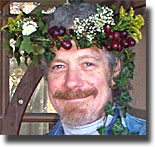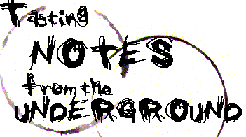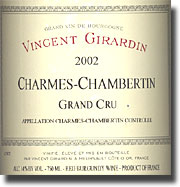|
2000 Domaine Rene Leclerc Gevrey Chambertin Combe Aux
Moines: Only the second wine from Rene Leclerc that we’ve had the pleasure to
enjoy (the
first being an entry level 2000 Bourgogne), this slightly
rusty ruby garnet is all about secondary characteristics at this point,
with no real fruit component to describe; what it does offer is a mix of
earthy forest floor, mushroom, leather, root beer, cola and old wood in
both flavor and aroma. Medium full bodied, with moderate tannins and
very good acids, the latter of which may do more to carry this for at
least a few more years of evolution, because while it’s drinking well
now, it has yet to reach its peak. Try again in 2010.
Find this wine
Imported by NWS, Inc., Chicago, IL
2005 Hamilton Russell Walker Bay Pinot Noir, 14.1% alc., $26.99:
After taking such delight in the
‘05 Hamilton Russell Walker Bay Chardonnay, there was no way we
weren’t going to give this ruby dark garnet Pinot Noir a try, and we
thought it only appropriate to open one with Sally and
Joel Goldberg,
who’ve actually visited this estate. It offers rich smoky plum and black
cherry flavors and aromas anchored with a nice earthy base; well
structured for at least five years of development and improvement, and
yet quite accessible now, showing a distinctive sense of finesse and
refinement. Joel offered the following impressions: “Just gorgeous;
opulent, yet elegant at the same time, a rare commodity in Pinot, I
think; so clearly New World, but not over the top.” I’d agree on each
count, as this is also clearly world class Pinot Noir.
From low-vigor, stony, clay-rich soil,
with a cool maritime mesoclimate, producing naturally tiny yields of
under 30 hl/ha; aged 9 months, 100% 228 liter French Oak Barrels -
Alliers 82% “Tight Grain” 18%; 1st fill - 42%, 2nd fill - 17%, 3rd fill
- 30%. 100% Malolactic, 5,380 cases produced.
Find this wine
Imported by Vineyard Brands, Inc., Birmingham, AL
2004 Rochioli Russian River Valley Pinot Noir, 14.2% alc.: We opened
this smoky tinged ruby garnet
with Wyncroft’s Jim Lester, who’s always up for
investigating the varieties of the Pinot Noir experience, and it didn’t disappoint in the least, offering up rich, spicy, smoky black
cherry flavors and aromas overlaid with a subtle creaminess and chock full of that classic Rochioli personality. Lester added
impressions of “savory, not a flaw, perfectly made; Burgundian; doesn’t have the obvious faults that I associate with California Pinot.” This is indeed a beautiful wine, but
there’s no reason to be in any hurry to open it right away, because it has ample structure and
depth to age and improve for at least another three to five years.
Find this wine
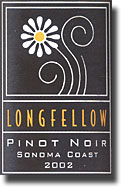 2002
Longfellow Sonoma Coast Pinot Noir, 14.4% alc., $35: The local
distributor gave me a sample of this ever-so-slightly-cloudy ruby
garnet, telling me that it’s really good. “It got 90 points,” he added,
not telling me who the generous benefactor of said points was. I
performed a web search and found that it has indeed received some good
press (but couldn’t find 90 points worth, although I really didn’t
search that long and that’s really not important to us anyway), so we
opened this to have with a chorizo and green bean omelet topped with
some nice goat cheese to decide for ourselves. We were at first struck
by the heat it showed on both the nose and in the mouth, accompanied by
almost searing acidity. After about 40 minutes however, these tone down
nicely so that the smoky (wood smoke is really the dominant
characteristic of this wine), earthy black cherry and dark plum flavors
and aromas, all shaded with a little leather, come to the fore and give
a very good account of themselves. The acids are still zippy, and
there’s a good tannic backbone to this, so given the concentration and
intensity it shows on its medium-full bodied frame, there’s no reason to
think that it’s not still on the way up, with at least another two or
three years of improvement and some staying power after that. All in
all, a pretty darned nice Pinot Noir; just remember to give it some air
before you try it.
Find this wine 2002
Longfellow Sonoma Coast Pinot Noir, 14.4% alc., $35: The local
distributor gave me a sample of this ever-so-slightly-cloudy ruby
garnet, telling me that it’s really good. “It got 90 points,” he added,
not telling me who the generous benefactor of said points was. I
performed a web search and found that it has indeed received some good
press (but couldn’t find 90 points worth, although I really didn’t
search that long and that’s really not important to us anyway), so we
opened this to have with a chorizo and green bean omelet topped with
some nice goat cheese to decide for ourselves. We were at first struck
by the heat it showed on both the nose and in the mouth, accompanied by
almost searing acidity. After about 40 minutes however, these tone down
nicely so that the smoky (wood smoke is really the dominant
characteristic of this wine), earthy black cherry and dark plum flavors
and aromas, all shaded with a little leather, come to the fore and give
a very good account of themselves. The acids are still zippy, and
there’s a good tannic backbone to this, so given the concentration and
intensity it shows on its medium-full bodied frame, there’s no reason to
think that it’s not still on the way up, with at least another two or
three years of improvement and some staying power after that. All in
all, a pretty darned nice Pinot Noir; just remember to give it some air
before you try it.
Find this wine
2005 Castle Rock Russian River Valley Pinot Noir
Reserve, 14.5% alc., $21.99:
Ruby dark garnet color, with a stingy nose giving only some grudging
earthy, smoky black cherry, but it picks things up nicely on the palate,
with rich, creamy oak, black cherry and plum flavors with subtle earthy
undertones. Decent structure, with moderate tannins, good acidity and a
reasonable finish; not too heavy, not too extracted, not too much oak. A
nice RRV Pinot Noir for under $20?! It is if you figure in a 10% case
discount, and even if it’s not going to win many blind tastings, it’s
worth buying by the case. Kim likes it, and so do I.
Find this wine
2001 Edmunds
St. John San Luis Obispo Syrah Bassetti Vineyard, 13.7% alc.:
Skip Telgard, the owner of
Leland,
Michigan’s Bluebird Restaurant opened this slightly cloudy dark
garnet Syrah for us during a recent visit to that fine establishment. It
shows a slightly barnyard-y nose of leathery black plum and blackberry
shaded with hints of iodine, following through on the palate with more
of the same characteristics, both earthy and rich at the same time. Full
bodied, with big structure, but very smooth and accessible with some
air, as more leather emerges in the flavor profile. Pure excellent
California Syrah, permeated with Steve Edmunds’
fine touch, it shows great promise for further development, so drink or
hold. "Bassetti Vineyard is in a small
valley, surrounded by the massive coastal hills around Cambria, just a
couple of miles from the Pacific. The vines grow, for the most part, on
a knoll that is comprised, primarily, of volcanic rock. Growing season
is generally long and very mild, so ripening is slow, and late. This is
real cold-climate Syrah.
Approximately 3 and1/2 tons were picked in the fourth week of October,
and de-stemmed into small, open-top fermenters, and during the 11 day
cuvaison, the cap was punched down manually 2-4 times each day. The wine
was pressed, at dryness, into 19 year old French puncheons. It was
racked at roughly 6 month intervals, and again before bottling, in July
of 2003." – from the Edmunds St. John website
Find this wine
2001 Marqués de Cáceres Rioja Reserva, 13.5% alc., $23: Dark
garnet in color, with a boatload of oak on the nose that gives it a
caramel-vanilla character that I probably would have enjoyed 15 years
ago, but just seems to get in the way of some red currant and cherry
flavors and aromas when it’s first poured. However, give it an hour’s
worth of air, and much (but not all) of the more objectionable woody
character soaks in to the rich, ripe fruit and a nice leathery undertone
emerges. Medium full to full bodied and deceptively well structured,
giving no reason not to think that it won’t continue to develop and
improve for at least five to eight years, but then, there’s no reason
not to open one tonight either, with the qualification that I would
certainly give it an hour in a decanter before drinking. I’d like to try
one of these and one of the following selections from an older vintage
to see just how they evolve with ten years or more.
Made from old vine Tempranillo (85%),
with the balance split between the Graciano and Mazuelo. Aged in French
Limousin barrels for a minimum of 24 months, followed by as much as 4
years or more in bottle, and made only in the best vintages.
Find this wine
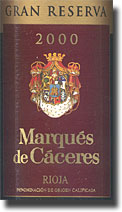 2000
Marqués de Cáceres Rioja Gran Reserva, 13.5% alc., $30: Brown sugar
and mint stand out on the nose when this dark garnet is poured straight
from the bottle; on the palate, it offers deep and fairly dark black
cherry along with a broad spectrum of red and black currants and
berries, all shaded with earthy undertones and the afore-mentioned oak
induced accents. Thick, rich and substantial, even plum, with good
structure and considerably more depth than the Reserva, and like that
one, some air really helps it to soak up the excessive oak influence,
and in fact, I like it just fine. Made
from old vine Tempranillo (85%), Graciano and Mazuelo, aged up to 30
months in oak and at least 4 years in the bottle. Produced only from
vintages classed as “excellent” or “very good”. 2000
Marqués de Cáceres Rioja Gran Reserva, 13.5% alc., $30: Brown sugar
and mint stand out on the nose when this dark garnet is poured straight
from the bottle; on the palate, it offers deep and fairly dark black
cherry along with a broad spectrum of red and black currants and
berries, all shaded with earthy undertones and the afore-mentioned oak
induced accents. Thick, rich and substantial, even plum, with good
structure and considerably more depth than the Reserva, and like that
one, some air really helps it to soak up the excessive oak influence,
and in fact, I like it just fine. Made
from old vine Tempranillo (85%), Graciano and Mazuelo, aged up to 30
months in oak and at least 4 years in the bottle. Produced only from
vintages classed as “excellent” or “very good”.
Find this wine
Marqués de Cáceres imported by Vineyard Brands, Inc.,
Birmingham, AL 2000 Castello di Bossi
Girolamo Toscana IGT, 13.5% alc.: This deep, dark garnet beauty is
all Merlot, and damned if Kim and I don’t like it a lot. It exudes a
lovely perfumed nose of black currant, blackberry, black cherry and dark
chocolate, with subtle floral overtones and just a hint of stemminess
way down deep; these impressions follow through on the palate with
wonderful depth, excellent structure and a lingering finish that should
grow even longer as the silky tannins gradually evaporate over the next
several years. I don’t often use “classy” to describe a wine, but in
this case, it fits. In fact, I find it almost reminiscent of a fine
Ridge something or other from the early to mid ‘90s, particularly in the
way that it makes a real style statement. A thoroughly modern wine in
the best sense of the term; many thanks to
Steve Kolody for this delicious treat.
Made from 100% Merlot, produced in
La Cantina, located 875-1,060 ft. above sea level, with a western
exposure and a clay and stone soil composition; the vineyard consists of
45 acres planted from 1970 through 1995, with a density of 2,160 vines
per acre. The vines are planted in the Spur pruned cordon method, with
yields of 2 tons per acre. Macerated for 18-20 days, with pump overs
for extraction; aged for two years in Allier barriques, followed by an
additional 3 years in bottle prior to release from the winery.
Find this wine
Imported by
Winebow Inc., New York, NY
We’ve tasted through a number of selections from the Australian producer
9
Stones over the last several weeks, and we’ve generally liked
what we tried. They make three Shiraz from three different appellations
that are otherwise treated almost exactly the same. We started with the ‘04s,
then moved on to two of the ‘05s.
2004 9 Stones McLaren Vale Shiraz: Dark garnet color, with a
pretty nose of ripe dark plum and berry laced with a bit of tar; a sweet
note on the nose isn’t as prevalent on the palate. Full bodied, with
good depth and length; well structured, more acidic than tannic, and
indeed, the acids border on shrill and excessive at this point, even
when paired with a deep-dish pizza heavily dosed with
Benton’s Bacon.
Find this wine
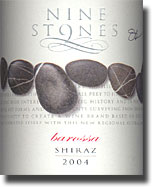 2004
9 Stones Barossa Shiraz: Dark garnet color, fading to pink at the
rim; shy nose of sea air and dark plum and berry. Flavors almost seem a
bit flat compared to the McLaren Vale, giving dusty dark plum,
blackberry and beet root, with good acids, medium tannins and good
balance overall. Fairly rich, but certainly no gobby fruit bomb (that’s
not what any of these are all about); with air, some creamy oak reveals
itself and not necessarily in a bad way.
Find this wine 2004
9 Stones Barossa Shiraz: Dark garnet color, fading to pink at the
rim; shy nose of sea air and dark plum and berry. Flavors almost seem a
bit flat compared to the McLaren Vale, giving dusty dark plum,
blackberry and beet root, with good acids, medium tannins and good
balance overall. Fairly rich, but certainly no gobby fruit bomb (that’s
not what any of these are all about); with air, some creamy oak reveals
itself and not necessarily in a bad way.
Find this wine
2004 9 Stones Hilltops Shiraz: Dark garnet color, fading to
purple-pink at the rim; the tarry dark plum and blackberry nose leads
into ripe, earthy, tarry black plum and blackberry flavors; ripe, but
not overly ripe, with good structure and balance. Some charred oak makes
its presence known with a little air, but it’s a minor role well-played
in the ensemble of components in the greater whole of the wine, and
extended air helps it even more. A solid, food friendly Shiraz.
“Hilltops is in the South-Western Slopes
of the Great Dividing Range, situated around the rural towns of Young
and Harden in Southern New South Wales. It is about four hours drive
south of Sydney and about one and a half hours from Canberra the
national capital. An historically important part of Australia, it has an
established reputation as a producer of high quality stone fruit. The
vineyards are mostly to the South East of Young, which is known as "The
Cherry Capital of Australia" and there are about 1,000 acres under vine
in the area. The region sits on a large granite rock, which over
millions of years has weathered to produce deep topsoil, red coloured as
it has mixed with ironstone sand blown in from the Red Centre of
Australia. These deep well-drained soils are perfect for viticulture. An
average altitude of 1,700 feet combines with a winter dominant rainfall
to ensure a long and even ripening season that produces distinctly full-flavoured,
yet not heavy wines. Because of the altitude, the grapes seldom suffer
from heat stress.” – from the 9 Stones
website
Find this wine
I mostly like the ‘04s, with the Barossa being my favorite and the
Hilltops a close 2nd; the
objectionable acids in the McLaren Vale are problematic at this point.
Here’re our impressions of two of the ‘05s.
2005 9 Stones Barossa, 14.3% alc., $11: Dark garnet color, not
quite reminiscent of ink; tar, earth and deep, dark black fruit on the
nose give way to plenty more of the same in the mouth, with very nice
balance and presence. The smooth texture takes a back seat to the
youthful fruit and a good dose of tannins that require either some time
in a decanter or some years in the cellar. A nice slice of grilled red
meat might make this more user friendly right now, but I’d probably opt
for holding off until 2010 or so to open another.
Machine and hand harvested in late April
2005. Fruit was crushed and de-stemmed, with fermentation in 20-ton
rotary fermenters for 10 days, with frequent pump over. Following
partial fermentation the pressings were added back to the free-run. The
wine completed fermentation and was then stored in new and seasoned
American oak hogsheads for 18 months. Filtered and bottled in early
March 2007.
Find this wine
2005 9 Stones McLaren Vale Shiraz, 14.2% alc., $11: Deep dark
garnet in color, and leathery, almost Rhône-ishly so; much more
approachable than the Barossa, though still in need of cellar time.
Flavors and aromas of earthy black plum, black currant and blackberry
shaded with the aforementioned leather and unencumbered with any excess
oak to speak of. There IS some wood present, but all the big, youthful,
rambunctious fruit soaks most of it up. Significant tannins, vibrant
acidity and good length; drink now with grilled red meats of give it at
least a few years to calm down a bit. Machine
harvested in April 2005; fruit was crushed and de-stemmed then fermented
in 20-ton capacity rotary fermenters for 7 days, with pump over 3 times
daily. Wine was drained and pressed at .5 Baume, with the pressings
added back to the free-run. Fermentation completed in a mix of new and
seasoned American oak hogsheads for 18 months. Filtered and bottled in
early March 2007.
Find this wine
9 Stones also makes a tasty Chardonnay that sees little oak and offers a
pure expression of varietal character, as well as a Hilltops
Cabernet-Merlot that we’ve yet to taste. Our impressions of these wines
are much more positive than otherwise, and as pointed out, they’re built
for at least short term aging.
9 Stones imported by Vineyard Brands, Inc., Birmingham,
AL
“What kind of food would you drink this with,”
I asked my better half,
“ice cream, or some kind of fruit pie?”
Finally, here’s one last red that we tried to say some good things
about, but simply couldn’t find any.
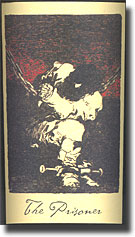 2005 Orin Swift
The Prisoner Napa Valley Red Wine, 48% Zinfandel, 26% Cabernet
Sauvignon, 14% Syrah, 10% Petite Sirah, 2% Charbono, 15.2% alc., $35.99:
I finally got a taste of this neighborhood crowd pleaser, thanks to a
sample bottle from the local distributor, and, at first, I was going to
state that I wouldn’t call the almost-opaque purple garnet a travesty or
an atrocity, because it’s not quite THAT bad (although it’s not even
close to anything that I’d refer to as real wine). But, the more I taste
it, the more it impresses me as a real deviant-kind-of-grape beverage.
There’s not much more than a little bramble-briar on the nose, and the
fat-a$$ toast, mocha, toffee and root beer flavors obliterate any
identifiable fruit. Full bodied, low in acids and a bit more than
moderately tannic, this is a poster child for what some folks refer to
as “spoofalated;” in short, it’s a manipulated, over-oaked wine. 2005 Orin Swift
The Prisoner Napa Valley Red Wine, 48% Zinfandel, 26% Cabernet
Sauvignon, 14% Syrah, 10% Petite Sirah, 2% Charbono, 15.2% alc., $35.99:
I finally got a taste of this neighborhood crowd pleaser, thanks to a
sample bottle from the local distributor, and, at first, I was going to
state that I wouldn’t call the almost-opaque purple garnet a travesty or
an atrocity, because it’s not quite THAT bad (although it’s not even
close to anything that I’d refer to as real wine). But, the more I taste
it, the more it impresses me as a real deviant-kind-of-grape beverage.
There’s not much more than a little bramble-briar on the nose, and the
fat-a$$ toast, mocha, toffee and root beer flavors obliterate any
identifiable fruit. Full bodied, low in acids and a bit more than
moderately tannic, this is a poster child for what some folks refer to
as “spoofalated;” in short, it’s a manipulated, over-oaked wine.
“What kind of food would you drink this with,” I asked my better half,
“ice cream, or some kind of fruit pie?” “Maybe the pie,” she replied,
because it surely doesn’t work with a good New York strip (I knew it
wouldn’t after the first sip, but went ahead with the match-up for the
sake of documentation). We decided that, despite its sweet nature, it
probably wouldn’t even work with BBQ beef or pork, because it doesn’t
have the acidity to stand up to the fatty character of the meat. BBQ
chicken, maybe? I don’t think so, and I’ll probably never find out,
because I’m not inclined to ever put this in my mouth again, but I’d
imagine that fans of Cinq Cepages will love it. The obviously Sine Qua
Non-esque label is a real plus too (snort!), but that’s been hashed over
already.
Find this wine
You can fool some of the people some of the time, but you can’t fool all of the people all of the time…
Reporting from Day-twah,
Bastardo

Other Recent Wine Explorations
Mr. Dan's Wild Ride
Red Wings and Red
Rhônes Playoff Diary-Round Three
A Bunch O' Whites
(& One Pinky)
Left Foot Charley
Red Wings & Red Rhônes
Playoff Diary - Round Two
Better Red Than Dead
Red Wings & Red Rhônes
Playoff Diary - Round One
Back to the
July 2007 Index
Back to the Underground
Index
Back to the Top


© George Heritier July, 2007
|


